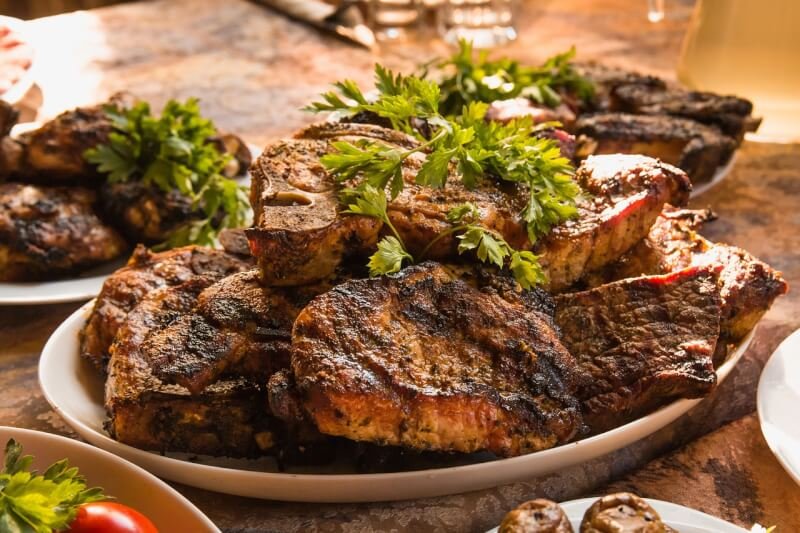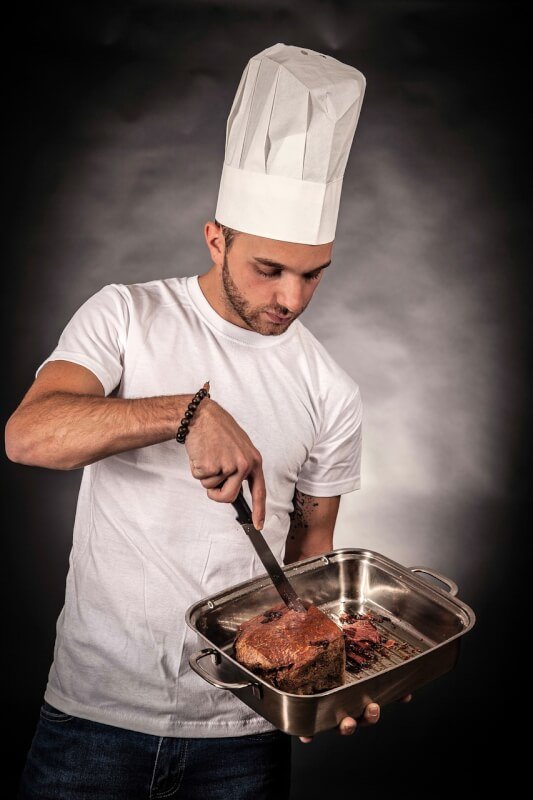Are you planning a trip to a high altitude destination and wondering how to cook meat properly up there? Well, you’re in luck! This article will provide you with all the essential guidelines to ensure your meat is cooked to perfection, even at high altitudes. From adjusting cooking times to mastering temperature control, you’ll soon be able to enjoy delicious, tender meat no matter how high up you are. So, let’s dive right in and discover the secrets to cooking meat at high altitudes!

Understanding the Impact of High Altitudes on Cooking
How High Altitudes Affect Cooking Times
Cooking at high altitudes can have a significant impact on cooking times. As you rise in altitude, the air pressure decreases, which means that water boils at a lower temperature. This lower boiling point has implications for various cooking methods, including boiling, steaming, and simmering. It is important to understand these changes in order to achieve the desired results in your cooking.
The Effect of Reduced Air Pressure on Boiling Point
At higher altitudes, the reduced air pressure causes water to boil at a lower temperature. The boiling point of water is typically 212 degrees Fahrenheit (100 degrees Celsius) at sea level. However, this temperature decreases by about 1 degree Fahrenheit for every 500 feet increase in altitude. This means that at an altitude of 5,000 feet, water will boil at around 202 degrees Fahrenheit (94 degrees Celsius). This decrease in boiling point affects the cooking time required for various recipes, especially those that involve boiling water or cooking liquids.
The Importance of Adjusting for Altitude in Meat Cooking
When cooking meat at high altitudes, it is crucial to make adjustments to ensure it cooks properly. The lower boiling point and reduced air pressure affect not only the cooking time but also the moisture retention and flavor development of the meat. Failure to make necessary adjustments can result in overcooked or undercooked meat, leading to an unpleasant dining experience. By understanding how altitude impacts meat cooking, you can make the necessary adjustments and achieve delicious results.
Choosing the Right Cooking Method
Grilling at High Altitudes
Grilling is a popular cooking method, and it can be adjusted for high altitudes. When grilling at higher elevations, it is important to adjust cooking times due to the drier air and reduced oxygen levels. Since meats can cook faster at high altitudes, it is crucial to monitor them closely to avoid overcooking. Additionally, using indirect heat and a meat thermometer can help ensure that the meat is cooked to the desired level of doneness.
Roasting and Baking Considerations
When roasting or baking meat at high altitudes, adjustments to cooking times and temperatures are necessary. As mentioned earlier, the lower boiling point affects the cooking time, so it is important to increase the cooking time to ensure the meat is thoroughly cooked. Additionally, since ovens may heat differently at higher altitudes, understanding your specific oven’s quirks and making necessary temperature adjustments is essential.
Using a Slow Cooker or Crock-Pot
Slow cookers, also known as crock-pots, can be a convenient option for cooking meat at high altitudes. The moist cooking environment helps prevent the meat from drying out, and the lower temperatures allow for even cooking over a longer period. However, it is essential to adjust the cooking time accordingly. Slow cookers at high altitudes may require longer cooking times to achieve the same level of tenderness and flavor as at sea level.
Stir-Frying and Sautéing Meat
Stir-frying and sautéing are quick and versatile cooking methods that can also be adapted for high altitudes. Since these methods involve cooking meat over high heat for a short period, the reduced air pressure may not have a significant impact on the cooking time. However, it is still important to monitor the cooking process closely, as meats can cook faster due to the drier air. Adjustments may be needed to ensure the meat is cooked to the desired level of doneness.

Understanding Temperature Adjustments
The Impact of Lower Boiling Points
The lower boiling point at high altitudes affects not only cooking times but also temperature adjustments in various cooking methods. To compensate for the lower boiling point, it is important to increase cooking temperatures. For example, when boiling pasta or simmering a soup, you may need to increase the heat to reach the desired temperature for proper cooking.
Adjusting Oven Temperatures
When using an oven at high altitudes, it is crucial to make temperature adjustments to ensure the meat cooks properly. Since ovens may heat differently at different altitudes, understanding your specific oven’s behavior is essential. Most recipes provide recommended cooking temperatures, but at higher elevations, it is generally advisable to increase the temperature by 25 degrees Fahrenheit (about 14 degrees Celsius) to compensate for the lower boiling point.
Thermometer Considerations
Using a meat thermometer is highly recommended when cooking meat at any altitude, but it becomes even more important at high altitudes. Since cooking times and temperatures may vary due to the reduced air pressure, a meat thermometer can help ensure that the meat reaches the appropriate internal temperature for safe consumption. It is essential to follow the USDA’s guidelines for safe internal temperatures for different types of meat.
Marinating for Moisture and Flavor
Why Marinating is Particularly Helpful at High Altitudes
Marinating meat is a popular technique that can help enhance both the moisture and flavor of the meat, which is especially important at high altitudes. The drier air at higher elevations can cause meat to dry out more easily during cooking. By marinating the meat before cooking, you can help retain moisture, resulting in a juicier final product.
Important Considerations for Marinating Meat
When marinating meat at high altitudes, there are a few important considerations to keep in mind. First, it is crucial to marinate the meat for an adequate amount of time to allow the flavors to penetrate. Since meats may cook faster at high altitudes, you may need to reduce the marinating time slightly to prevent the flavors from becoming overpowering. Additionally, it is important to properly handle and store the marinating meat to avoid any potential food safety issues.
Marinating Times at High Altitudes
The marinating times for meat at high altitudes may need to be adjusted slightly compared to those at sea level. Since the cooking time is generally shorter at higher elevations, reducing the marinating time can help ensure that the meat does not become overly saturated with flavors. It is recommended to reduce the marinating time by about 15-20% when cooking meat at high altitudes. However, the specific marinating times can vary depending on the type of meat, its thickness, and the recipe being used.

Safety Guidelines for Cooking Meat at High Altitudes
Proper Handling and Storage of Meat
When cooking meat at any altitude, proper handling and storage are crucial for food safety. It is important to keep raw meat separate from other ingredients to avoid cross-contamination. The meat should be stored in the refrigerator or freezer at appropriate temperatures to prevent bacterial growth. Thawing meat in the refrigerator or using the defrost function on the microwave are safe methods to ensure even thawing and minimize the risk of bacteria growth.
Ensuring Meat is Cooked to Safe Internal Temperatures
Cooking meat to safe internal temperatures is essential for food safety. At high altitudes, it becomes even more important to ensure that the meat reaches the recommended temperature for the specific type of meat being cooked. Using a meat thermometer to check the internal temperature is the most accurate way to determine the meat’s doneness. The USDA provides guidelines for safe internal temperatures for various types of meat, including beef, pork, poultry, and fish.
Avoiding Cross-Contamination
Cross-contamination can lead to foodborne illnesses, so it is important to take preventive measures when handling raw meat. This includes using separate cutting boards, utensils, and plates for raw and cooked meat. Washing hands thoroughly with warm water and soap after handling raw meat is a crucial step in preventing the spread of bacteria. Following these guidelines will help ensure that your cooked meat is safe for consumption.
Specific Meat Recommendations
Beef and Steak Guidelines
When cooking beef or steak at high altitudes, there are a few recommendations to keep in mind. It is important to choose cuts of meat that are suitable for the cooking method you plan to use. Tender cuts, such as ribeye or filet mignon, are well-suited for grilling or broiling. Tougher cuts, like chuck roast or brisket, are better suited for slow cooking methods such as braising or using a slow cooker. Using a meat thermometer to check the internal temperature is essential for achieving the desired level of doneness.
Pork Cooking Considerations
When cooking pork at high altitudes, similar principles apply as with other meats. The cooking time and temperature may need to be adjusted to accommodate the reduced air pressure and lower boiling point. Pork is safe to eat when the internal temperature reaches 145 degrees Fahrenheit (63 degrees Celsius) with a 3-minute rest time. Cooking pork to the recommended internal temperature ensures that it is safe to consume while still maintaining its juiciness and flavor.
Poultry Tips and Tricks
When cooking poultry at high altitudes, it is particularly important to ensure that it reaches the appropriate internal temperature for safety. Chicken and turkey should be cooked to a minimum internal temperature of 165 degrees Fahrenheit (74 degrees Celsius) to eliminate any potential harmful bacteria. Adjustments to cooking times and thermometer usage will ensure that poultry is thoroughly cooked and safe to eat.
Fish and Seafood Cooking Techniques
Cooking fish and seafood at high altitudes can be a bit different due to their delicate nature. Since fish and seafood tend to cook faster than meat, it is crucial to monitor their cooking closely to prevent overcooking. Using methods such as grilling in foil packets, baking, or pan-searing can help retain moisture and flavor. Adjustments to cooking times may be necessary, and using a meat thermometer can help ensure that the fish is cooked to the proper internal temperature.
Altitude Adjustment Tips for Grilling
Preheating the Grill
When grilling at high altitudes, it is important to preheat the grill thoroughly before placing the meat on the grates. This ensures that the grill reaches the desired cooking temperature and helps prevent sticking. Properly preheating the grill will enhance the searing process and result in juicy, flavorful meat.
Temperature Control and Flare-Ups
Controlling the temperature on the grill can be more challenging at high altitudes due to the drier air. Using indirect heat and adjusting the grill’s vents can help regulate the temperature and prevent flare-ups. Keeping a spray bottle with water nearby can also help dampen any excessive flare-ups and control the cooking process.
Grilling Time Adjustments
Grilling times at high altitudes may need to be adjusted since meats can cook faster due to the reduced air pressure. It is important to monitor the meat closely and reduce the cooking time accordingly. Using a meat thermometer to check the internal temperature is the most reliable way to determine when the meat is cooked to perfection. Experimenting with different cuts of meat and adjusting the cooking time will help you find the perfect balance for grilling at high altitudes.
Tips for Roasting and Baking at High Altitudes
Roasting Temperature Adjustments
When roasting meat at high altitudes, it is important to adjust the cooking temperature to compensate for the lower boiling point. Increasing the oven temperature by about 25 degrees Fahrenheit (about 14 degrees Celsius) is a good starting point. However, it is essential to monitor the cooking process closely and adjust the temperature as needed to achieve the desired level of doneness.
Baking Powder and Baking Soda Considerations
In baking, altitude can affect the performance of leavening agents such as baking powder and baking soda. The reduced air pressure at higher elevations can cause baked goods to rise more quickly and then collapse. To counteract this, it is advisable to slightly reduce the amount of leavening agents used in recipes. Experimenting with different ratios and adjusting baking times can help achieve consistent and desirable results.
Understanding Leavening Agents
Leavening agents play a crucial role in baking, and their effectiveness can be affected by altitude. Baking powder and baking soda release gases that help the batter or dough rise during baking. At high altitudes, the reduced air pressure can cause these gases to expand more rapidly, leading to over-rising and then collapsing. To prevent this, it is important to use the appropriate amount of leavening agents and make necessary adjustments to the baking time.
Slow Cooking and Crock-Pot Tips
Slow Cooker Temperature Adjustments
Slow cookers or crock-pots can be great tools for cooking meat at high altitudes. Since slow cookers use a lower cooking temperature over a longer period, adjustments may need to be made to accommodate variations in altitude. Generally, increasing the cooking time by about 15-20% compared to sea level is a good starting point. However, it is important to monitor the meat’s progress and adjust the cooking time accordingly.
Choosing the Right Cuts of Meat
When using a slow cooker at high altitudes, it is advisable to choose cuts of meat that are well-suited for slow cooking. Tougher cuts, such as chuck roast or pork shoulder, benefit from the longer cooking time and low temperature. These cuts break down collagen and connective tissues, resulting in tender and flavorful meat. Selecting the right cuts of meat is essential for achieving delicious results in a slow cooker at high altitudes.
Liquid Adjustments for Moisture
In slow cooking, the moisture content is an important factor in achieving tender and juicy meat. At high altitudes, the reduced air pressure can cause more evaporation during the cooking process. To compensate for this, it may be necessary to increase the amount of liquid, such as broth or sauce, in the slow cooker. This additional liquid helps maintain moisture levels and prevents the meat from drying out during extended cooking times.
Summary and Conclusion
Key Points to Remember
Cooking meat at high altitudes requires adjustments to compensate for the lower boiling point, reduced air pressure, and faster cooking times. It is important to monitor cooking times closely, make temperature adjustments, and use a meat thermometer to ensure the meat reaches the proper internal temperature for safe consumption. Marinating meat can help retain moisture and enhance flavors, while proper handling and storage of meat are crucial for food safety.
Experimenting with Altitude Cooking
Cooking at high altitudes provides a unique culinary experience, and it is an opportunity to experiment with different cooking methods and flavors. Understanding how altitude affects cooking times and temperatures allows you to adapt and make necessary adjustments for delicious results. By experimenting and fine-tuning your techniques, you can create mouthwatering meals that showcase the flavors of high-altitude cooking.
Enjoying Delicious Meats at High Altitudes
With the guidelines and recommendations outlined in this article, you are well-equipped to cook meat at high altitudes with confidence. Whether you prefer grilling, roasting, slow cooking, or stir-frying, understanding the impact of altitude on cooking allows you to enjoy delicious meats that are cooked to perfection. By considering the altitude adjustments, temperature control, marinating techniques, and safety guidelines, you can elevate your culinary skills and create memorable meals at high altitudes.


